nRF5 action!
-
@Mike_Lemo said in nRF5 Bluetooth action!:
sins alot of functionality isn't supported
If your abandoning from Arduino, what will you be abandoning to?
@NeverDie said in nRF5 Bluetooth action!:
@Mike_Lemo said in nRF5 Bluetooth action!:
sins alot of functionality isn't supported
If your abandoning from Arduino, what will you be abandoning to?
Probably eclipse
-
@NeverDie said in nRF5 Bluetooth action!:
@Mike_Lemo said in nRF5 Bluetooth action!:
sins alot of functionality isn't supported
If your abandoning from Arduino, what will you be abandoning to?
Probably eclipse
@Mike_Lemo said in nRF5 Bluetooth action!:
@NeverDie said in nRF5 Bluetooth action!:
@Mike_Lemo said in nRF5 Bluetooth action!:
sins alot of functionality isn't supported
If your abandoning from Arduino, what will you be abandoning to?
Probably eclipse
I'm rather hazy on the differences. I guess that way you can use all the Nordic libraries the way they were intended?
-
Eclipse is just an IDE ;) like Arduino IDE, or VS etc.
I think he means he wants to leave arduino core (mysensors rely on arduino core) to use nordic sdk with other ide (like eclipse, mbed, keil etc..). Because using eclipse with arduino core won't unlock features. It still needs coding. -
Eclipse is just an IDE ;) like Arduino IDE, or VS etc.
I think he means he wants to leave arduino core (mysensors rely on arduino core) to use nordic sdk with other ide (like eclipse, mbed, keil etc..). Because using eclipse with arduino core won't unlock features. It still needs coding. -
Bluetooth is everywhere, and that's great, but I'm developing the impression that Bluetooth is rather arduous to program in its "native" format. Maybe this is an opportunity to build something simpler/easier that runs on top of Bluetooth, and yet can still interact with normal bluetooth devices in the native bluetooth that they understand? I think the Arduino's wide acceptance more or less proves that "easy is good."
-
Bluetooth is everywhere, and that's great, but I'm developing the impression that Bluetooth is rather arduous to program in its "native" format. Maybe this is an opportunity to build something simpler/easier that runs on top of Bluetooth, and yet can still interact with normal bluetooth devices in the native bluetooth that they understand? I think the Arduino's wide acceptance more or less proves that "easy is good."
-
OK, here's my plan:
-
It's possible the connections on my first attempt were a bit dodgy. I'll try again, but this time soldering a fresh new module to a prototype PCB so that they won't be mechanically stressed as I interconnect wires. Not as ideal as my breakout board will be, but I'll have to make do until it arrives.
-
If it still fails to program after step #1, then I'll check to confirm whether or not the oscillators are, uh, oscillating, at the proper frequency by using an oscilliscope after powering it up. I'm assuming they are, but it's at least easy to check and then cross off the list of suspects.
-
If still no clues, then what's next? Logic probe on the two SW lines for a compare/contrast against a successful programming of a sparkfun nRF52832 board? That's sure to generate at least some palpable data as to where the problem is occurring.
I welcome other suggestions though on how to proceed. The above is just my best guess, and I'm sure others here are better at troubleshooting this than I am.
@NeverDie said in nRF5 Bluetooth action!:
OK, here's my plan:
-
It's possible the connections on my first attempt were a bit dodgy. I'll try again, but this time soldering a fresh new module to a prototype PCB so that they won't be mechanically stressed as I interconnect wires. Not as ideal as my breakout board will be, but I'll have to make do until it arrives.
-
If it still fails to program after step #1, then I'll check to confirm whether or not the oscillators are, uh, oscillating, at the proper frequency by using an oscilliscope after powering it up. I'm assuming they are, but it's at least easy to check and then cross off the list of suspects.
-
If still no clues, then what's next? Logic probe on the two SW lines for a compare/contrast against a successful programming of a sparkfun nRF52832 board? That's sure to generate at least some palpable data as to where the problem is occurring.
I welcome other suggestions though on how to proceed. The above is just my best guess, and I'm sure others here are better at troubleshooting this than I am.
I executed step #1 of my plan with no change in results on the second attempt of programming. The module is definitely getting 3.3v power on the VCC pin.
So, I executed step #2. I don't see any oscillation at all on the 32.7khz oscillator. The faster oscillator is mostly quiet, but it periodically gives short little bursts of activity--here's a screenshot of one:
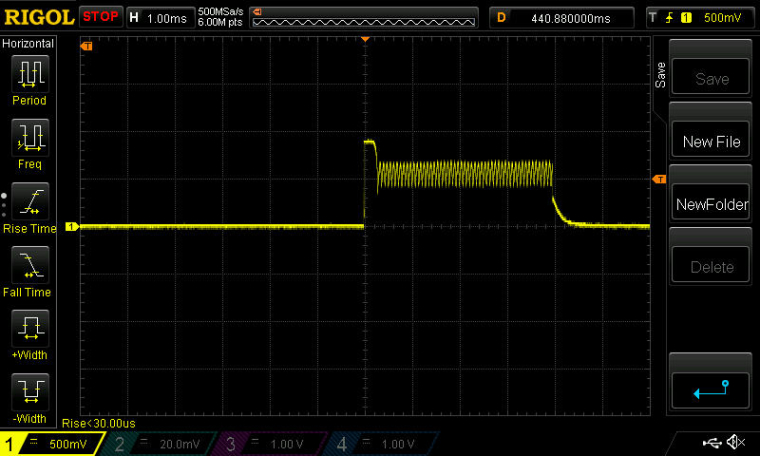
Not sure if this is normal or not, but that's what is going on. -
-
@scalz arduino.org ble library that's based on sandeepmistry's one seems very extensive.
I believe one need pretty substantial reasons to migrate from arduino unless you are a professional developer -
So, for comparison, I measured the Sparkfun nRF52832 board, because (unlike the adafruit with its Raytac module), both oscillators are exposed for measurement. Unfortunately, it is already programmed, so it is not a true apples-to-apples comparison, but, anyway, the measurements were definitely different. First of all, the 32.7Khz oscillator was continuously oscillating at around 32.9Khz:
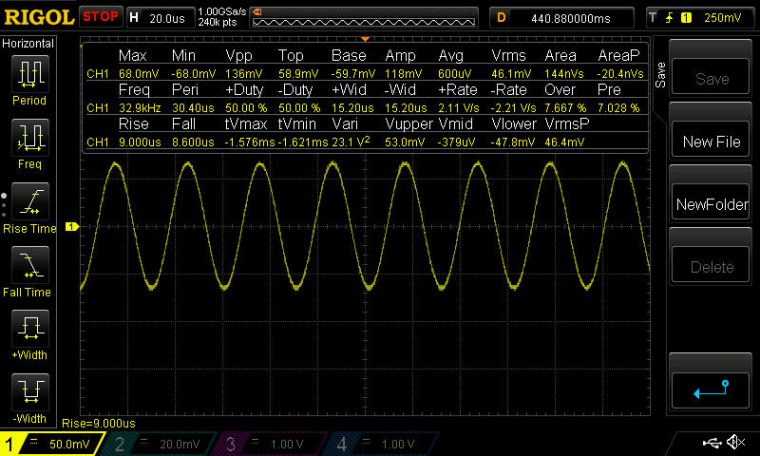
and the faster oscillator was also continuously oscillating:
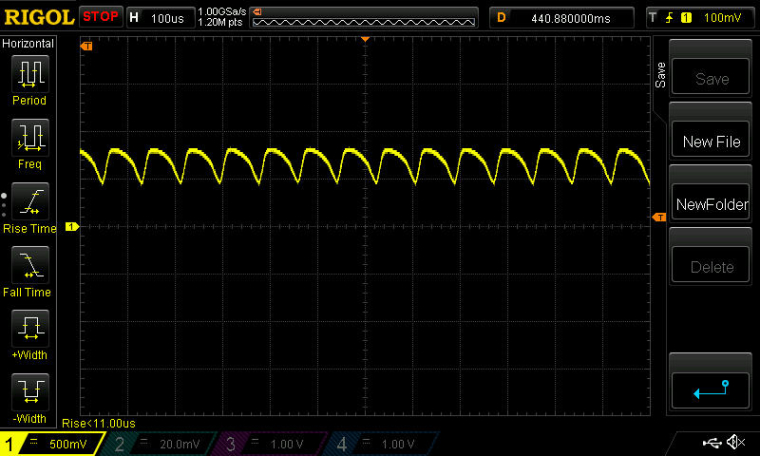
I guess to have an apples-to-apples I would have to completely erase the firmware on the Sparkfun board.Anyhow, I think I'm getting the urge to order some Raytac modules.... It sounds as though they are not such a mystery.
-
One thing I notice on the Ebyte module is that no RESET pin is exposed. Isn't that a bit odd?
Also, there appears to be a typo on the silkscreen, where there are two pin 7's on the silkscreen, but probably one of them is actually pin 6.
-
By the way, those short bursts on activity on the Ebyte module's fast oscillator happen pretty regularly, about every 22ms or so:
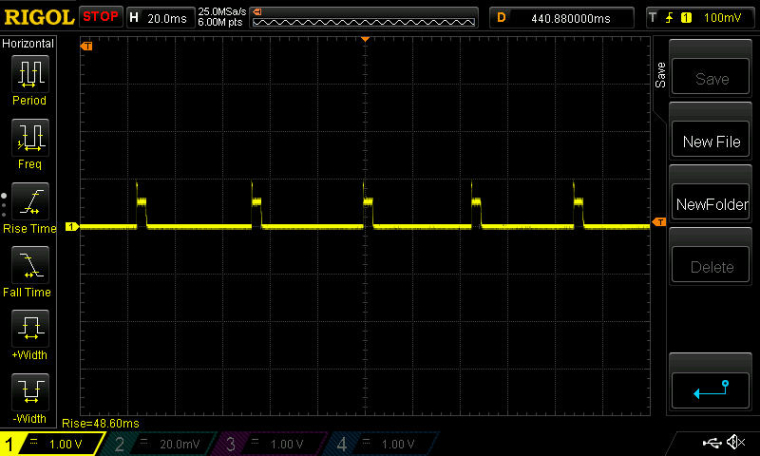
-
@Toyman what is that libray? I think of you refer to bel peripheral v0.3 it might not support the nrf52832 as I was asking before.
http://www.arduino.org/learning/reference/ble
This is their "homework" in anticipation of Primo launch. It does support nrf52
-
Ok, so after posting some questions to CDSENET Aliexpress store(in regards to the E73-2G4M04S module):
1. Is the nrf52832 IC DEC1 pin decoupled with a 100nF capacitor as per Nordic datasheet recommendations? 2. Is the nrf52832 IC DEC2 pin decoupled with a 100pF capacitor as per Nordic datasheet recommendations? 3. Are all the power pins of the nrf52832 IC decoupled as per Nordic datasheet recommendations? 4. Are the external components already provided so that the internal DC-DC converter can be used?I received this part of schematic:
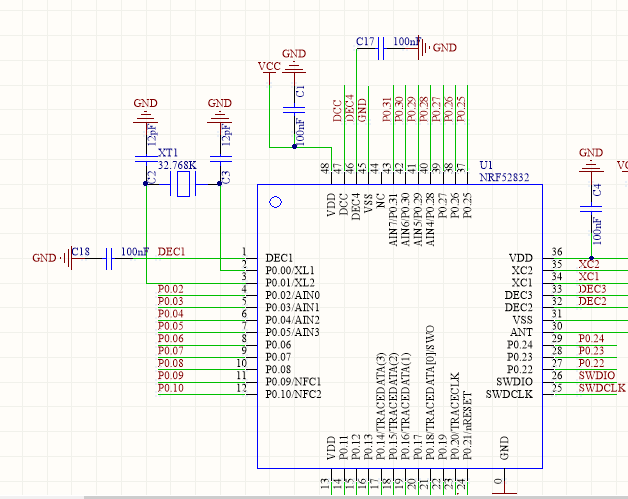
The module that I bought is this one: CDSENET E73-2G4M04S
I hope that it helps demystify some things in regards to this module. Maybe @NeverDie can confirm this by checking his module connections as seen in the above schematic. I'm saying this because Chinese support is well..not so user friendly in my experience and I don't know if the above schematic is indeed what they used on their module or they just provided me an example schematic of how to use the NRF52832 IC in general instead.
-
@Mike_Lemo @Toyman
BLEPeripheral lib from sandeep is working fine with nrf52832, as i'm using it ;)Regarding the sch above, it looks like a classic circuit (in LDO mode, not surprising as DCDC mode is optional). I'm not using same values but this should work..
-
They sent me two files, but I have no idea what they are, or how to open them. Maybe someone here recognizes them or can open them?
0_1500890784640_E73-2G4M04S-PCBLIB.PCBLIB
0_1500890793687_E73-2G4M04S-PCB-V1.0.PCBDOCPreview -
@Mike_Lemo @Toyman
BLEPeripheral lib from sandeep is working fine with nrf52832, as i'm using it ;)Regarding the sch above, it looks like a classic circuit (in LDO mode, not surprising as DCDC mode is optional). I'm not using same values but this should work..
@scalz said in nRF5 Bluetooth action!:
Regarding the sch above, it looks like a classic circuit (in LDO mode, not surprising as DCDC mode is optional). I'm not using same values but this should work..
From what little I've read in the nRF52832 datasheet (and please do correct me if I'm wrong), the LDO mode is the "default", and is not as power efficient as the DCDC mode. Not good, as most of us probably want this for battery operation. Therefore, even if it were to work in LDO mode, what we should probably want is the DCDC mode. So, are we screwed? Or, can DCDC mode be easily applied on top of whatever they've already hardwired in the module by just adding a few more components?
-
http://www.arduino.org/learning/reference/ble
This is their "homework" in anticipation of Primo launch. It does support nrf52
@Toyman said in nRF5 Bluetooth action!:
http://www.arduino.org/learning/reference/ble
This is their "homework" in anticipation of Primo launch. It does support nrf52
@scalz said in nRF5 Bluetooth action!:
@Mike_Lemo @Toyman
BLEPeripheral lib from sandeep is working fine with nrf52832, as i'm using it ;)Regarding the sch above, it looks like a classic circuit (in LDO mode, not surprising as DCDC mode is optional). I'm not using same values but this should work..
If you say so that's great I've downloaded that BLEPeripheral library opened one of the test and led examples and there are a few things I don't understand why would I have to define those IRQ pins and include SPI library to use the BLE on board?
If order to send data back and forth between peripheral and central you have to use this function:?
to read: switchCharacteristic.value();
to write:characteristic.setValue(value, length);do you maybe have a little simple example to establish a connecting between central and peripheral with sending random data and peripheral and a smartphone?
-
@scalz said in nRF5 Bluetooth action!:
Regarding the sch above, it looks like a classic circuit (in LDO mode, not surprising as DCDC mode is optional). I'm not using same values but this should work..
From what little I've read in the nRF52832 datasheet (and please do correct me if I'm wrong), the LDO mode is the "default", and is not as power efficient as the DCDC mode. Not good, as most of us probably want this for battery operation. Therefore, even if it were to work in LDO mode, what we should probably want is the DCDC mode. So, are we screwed? Or, can DCDC mode be easily applied on top of whatever they've already hardwired in the module by just adding a few more components?
For DC-DC converter you need to add some external inductor(s) and some capacitor to the DCC pin if I remember correctly. This can be observed here:
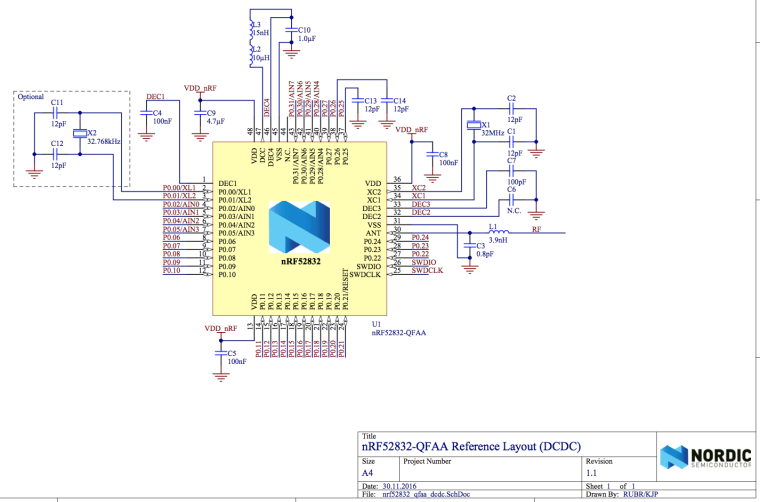
And more than that it needs to be enabled from the SDK also.
I didn't read the official datasheet and the recommendations from it yet...so I don't know all the implications.
From what I've read so far this needs to be added before anything else(I think a good place is the
beforehook from MySensors):void before() { NRF_POWER->DCDCEN = 1; }And maybe this will shed some light too: https://devzone.nordicsemi.com/question/69091/a-question-about-nrf52832s-dcdc-and-ldo/
-
@mtiutiu there is a little confusion :) this is the reference sch for nrf51. It is a bit different for nrf52.
@Mike_Lemo no you dont need to set these pins which could be removed from the init function.
Yes these functions are used for ble comm.
I think sharing my unfinished code is useless (arduino & phone) if you have troubles with arduino examples. I have no time for an howto actually and little bit out of mysensors scope imho .The arduino examples are working fine.
There are already written howtos at sparkfun, adafruit, blogs etc
If you need more infos, maybe you can get more help on arduino forum too..
And for general understanding of ble and its mechanisms (providers, services, characteristics..), you can take a look at bluetooth sig.
Finally for custom phone app, you have to code with your preferred techno or use nordics app for simple debug
